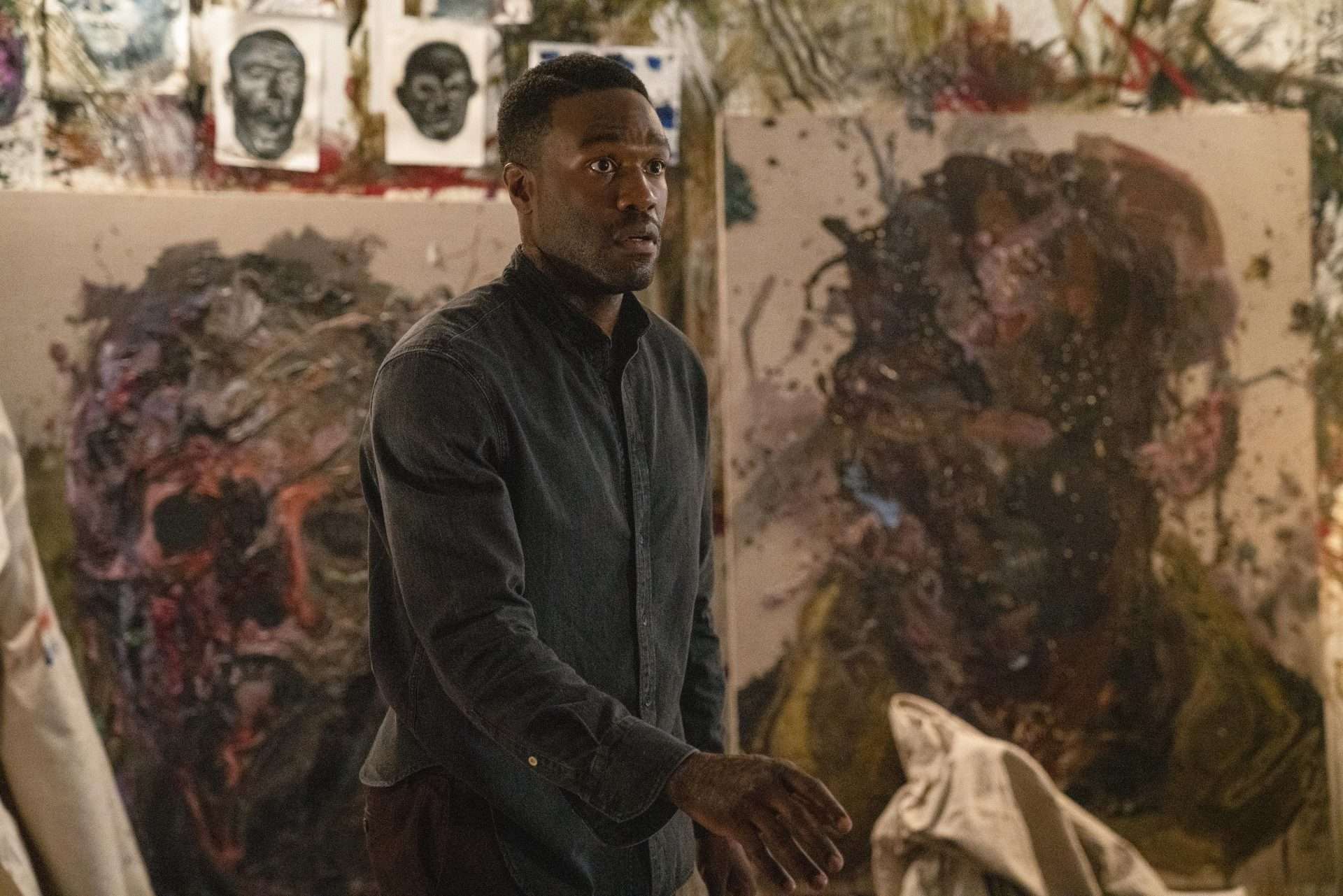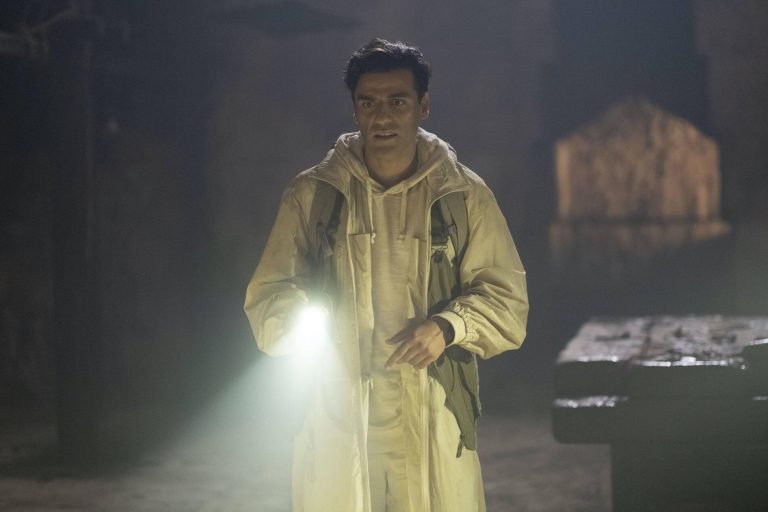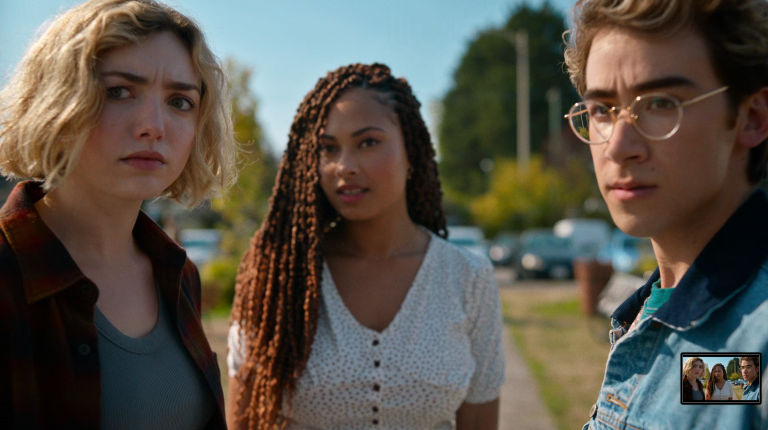Directed by Nia DaCosta, the 2021 horror-thriller Candyman is both visually captivating and thematically profound. It reinvents the classic tale of racial injustice through a contemporary lens, offering a fresh and thought-provoking perspective on an enduring legend. The story follows Anthony McCoy, a Chicago artist in search of inspiration to bring depth to his work.
Anthony’s quest leads him to Cabrini-Green, an abandoned housing project shrouded in dark history and chilling urban myths. As he becomes entangled in the Candyman legend, unsettling truths begin to emerge, and his art takes a disturbingly eerie turn. Anthony’s transformation becomes increasingly sinister, leaving audiences to question: is the Candyman legend more than just folklore? To uncover the truth, let’s delve into the rich layers of this reimagined story.
Spoilers Ahead.
Candyman (2021) Plot Summary and Movie Synopsis:
What Happens in Cabrini Green?
The film begins in 1977, introducing a young William Burke living with his parents in the sprawling Cabrini-Green housing complex. At the time, the community is gripped with fear as the police search for a killer rumored to be hiding razor blades in candy. This suspect, known as Candyman, matches the description of Sherman Fields, a local man who often hands out sweets to children.
One day, while doing laundry in the building’s basement, Burke encounters Sherman. Startled by the unexpected meeting, Burke screams. However, Sherman does nothing to harm him and only offers him candy. Burke’s cry draws the attention of the police. They storm the basement and brutally beat Sherman to death without hesitation.
Unaware of the truth, Burke is left confused and traumatized, knowing Sherman poses no threat. The authorities, however, justify their actions by claiming Sherman fits the killer’s description. Later, it is revealed that razor-laden candies continue to appear near new victims, proving Sherman’s innocence. His unjust death becomes yet another chapter in the cycle of violence that fuels the Candyman legend.
How Does Anthony Bring Candyman Back?
Anthony McCoy, a Chicago-based artist, seeks inspiration for his work and stumbles upon the dark urban legend of the Candyman through Brianna’s brother, Troy. Drawn to the macabre tale of Helen Lyle and Cabrini-Green, he becomes fascinated by the tragic story of Sherman Fields, a man wrongfully killed by police after being falsely accused of hiding razor blades in candy. This encounter not only sparks Anthony’s creativity but also awakens an obsessive curiosity.
After hearing the legend from laundromat owner William Burke, Anthony jokingly summons the Candyman by reciting the infamous incantation in front of a mirror. This act, seemingly casual, sets in motion a chain of gruesome events. Unlike mere curiosity, Anthony’s deeper connection to the legend emerges as he integrates it into his art. His piece, “Say My Name,” intends to challenge perceptions of systemic violence and forgotten stories. Moreover, it becomes a sinister homage to Candyman. Through his work, Anthony unwittingly amplifies the myth, giving it renewed power and relevance.
Anthony’s descent into Candyman’s world begins with a seemingly innocuous bee sting on his hand. It’s a nod to the legend’s symbolic connection to bees. This sting festers, mirroring his growing obsession and physical transformation, suggesting that he is marked by Candyman’s presence. His escalating detachment from reality parallels his embrace of the legend, blurring the line between artist and victim.
Who is Helen Lyle?
Helen Lyle is a white graduate student who, in the 1990s, becomes obsessed with the Candyman legend while researching urban myths in Chicago’s Cabrini-Green housing projects. Her investigation leads her to uncover the tale of Daniel Robitaille. He was the original Candyman, and the subsequent cycle of violence and tragedy is tied to his legend.
Helen’s fixation escalates when she is framed for a series of murders and accused of abducting a baby. Helen ultimately sacrifices herself to save Anthony, perishing in a fiery confrontation with Candyman. She is remembered ambiguously, viewed either as a savior or a perpetrator. Helen’s actions stem from her desire to understand and expose systemic injustices represented by the Candyman myth. However, her relentless pursuit blinds her to the cultural and spiritual boundaries of Cabrini-Green, making her both a victim and an unintentional intruder.
How are Helen and Anthony Connected?
Anthony McCoy, now an artist in Chicago, is the baby Helen saved during her final confrontation with Candyman. Raised away from Cabrini-Green, Anthony grows up unaware of his connection to the legend until his mother, Anne-Marie, reveals the truth. His rediscovery begins when a bee sting leads him to obsessively paint gruesome portraits of the Candyman hive: innocent Black men wrongfully killed and absorbed into the legend.
Anthony’s transformation accelerates as he investigates Helen’s story and the Candyman myth. He learns that his identity is intrinsically tied to Cabrini-Green’s history. He was meant to be a sacrificial offering to perpetuate Candyman’s legacy. Helen’s intervention saved him, but the trauma of that night lingers in the silence surrounding his origin.
Helen and Anthony are connected by fate, both drawn into the Candyman’s cycle through their search for meaning. Helen seeks to document and challenge societal injustice, while Anthony’s art unknowingly resurrects it. Their stories illustrate how Candyman’s myth is both a curse and a reflection of collective pain, with Anthony inheriting the burden Helen once sought to confront.

Candyman (2021) Movie Ending Explained:
Burke: The Keeper of the Candyman Legacy
Burke serves as a custodian of the Candyman myth. He carries the weight of both supernatural lore and real-life trauma. His childhood is marked by two defining tragedies: witnessing his sister’s murder after summoning the original Candyman, Daniel Robitaille, and seeing Sherman Fields, an innocent man, beaten to death by police. These events scar Burke, leaving him as the sole witness to a cycle of systemic violence and supernatural revenge. Over time, Burke believes the Candyman legend is not just a curse but a necessary symbol of resistance and survival.
Burke kidnaps Anthony because he sees him as the ideal candidate to embody the next iteration of Candyman. Anthony’s connection to the legend runs deep: he was the baby saved by Helen Lyle during Candyman’s previous resurgence. Furthermore, his artistic obsession with the myth signals that he is already under its influence. To Burke, Anthony’s transformation is inevitable. He believes molding Anthony into Candyman will ensure the legend’s survival and renewal.
Is Burke a Villain or a Misguided Protector?
Burke’s actions are driven by a mix of trauma and a distorted sense of duty. He views the Candyman legend as a weapon against systemic racism and societal neglect. By perpetuating the myth, he believes he can protect his community from further harm by reminding the world of its injustices. When he tells Brianna, “Now we have a witness,” he signifies his desire to ensure the story continues, as witnessing is central to preserving the legend.
To Burke, the Candyman is not just a figure of horror but a necessary symbol of vengeance against a world that perpetuates violence against the innocent. Burke succumbs to despair, believing that maintaining the legend is the only way to give his community power amidst its suffering. This makes his kidnapping of Anthony both a tragic act of resignation and a misguided attempt at justice.
How is this Candyman Related to Tony Todd’s Candyman?
Tony Todd’s Candyman character, Daniel Robitaille, is the original figure at the heart of the legend. A 19th-century artist and the son of a slave, Daniel is lynched by a racist mob for having a relationship with a white woman. His brutal death, marked by honey, bees, and fire, transforms him into a vengeful spirit. Daniel becomes the first Candyman, embodying the rage and suffering of racial injustice. His story serves as the foundation for the myth.
Anthony McCoy becomes an extension of Candyman’s legacy in the 2021 film. He does not replace Daniel but rather continues the legend. Anthony’s journey, from an artist exploring the myth to his ultimate transformation into the Candyman, mirrors Daniel’s tragic trajectory. His connection to the legend is rooted in his history as the baby saved by Helen Lyle and his eventual fate as the next vessel for the Candyman spirit.
The 2021 film introduces the idea of a Candyman hive, a collective of souls who carry the legend. Each of them is a victim of racial violence. Sherman Fields, a man killed by police in the 1970s, is one such figure, but everything ties back to Daniel. By entrusting Anthony with the mantle, Daniel ensures that the Candyman legend evolves while remaining deeply anchored in its original mission: to immortalize injustice and call for retribution.
Will there be a Sequel to 2021’s Candyman?
The 2021 “Candyman” ends by reframing the titular character as more than just a single entity. Through Anthony’s transformation and Daniel Robitaille’s reappearance, the legend becomes a symbol of collective trauma and resistance against systemic oppression. The final scene, in which Candyman massacres the police and tells Brianna to “tell everyone,” sets the stage for a continuation. This closing directive implies that the Candyman legend must spread further, opening possibilities for exploring its impact in a new chapter.
By linking Anthony, Daniel Robitaille, and other victims of racial violence into a “hive,” the film expands the legend’s scope, making it relevant to modern audiences. A sequel could explore how Candyman’s myth evolves as Brianna carries the story forward, potentially placing her in a central role as a witness or even a target.







